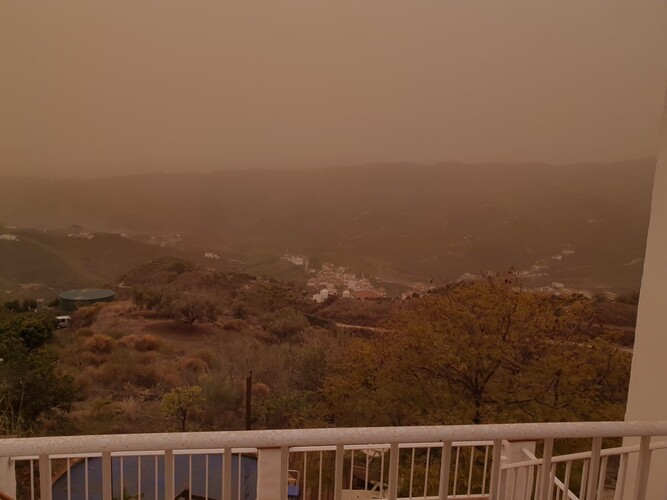MADRID – The Saharan dust blanket that has partly covered the Iberian Peninsula since Monday has led to an “exponential increase” in visits to health centres in southeastern Spain, in addition to unusual Martian images.
On Tuesday, March 15, and Wednesday, March 16, Spain was the most polluted country in the world due to the influx of this suspended Saharan dust that spread over the peninsula with a very unusual intensity. People needed medical attention because of respiratory problems caused by breathing air full of dust particles.
Others lamented the brown-orange haze of mud that the meteorological phenomenon ‘calima’ left on their properties. Everything that was white turns brown and dirty until the next heavy rain shower and once clear blue swimming pools are now murky.
Natural fertiliser
However, not all the consequences of this cloud of Sahara sand driven by storm Celia are negative: Experts point out that it is also a good natural fertiliser. How? Surface dust deposits are a source of micronutrients for both terrestrial and marine ecosystems. Researchers, therefore, assume that dust from the Sahara fertilises the Amazon rainforest.
Nutrition for phytoplankton
The iron and phosphorus that the dust transports aid the production of marine biomass in areas of the oceans where these elements are scarce. The minerals that are soluble in water are used by marine phytoplankton to feed.
Two positive things happen with these phytoplankton fertilisers: it absorbs carbon dioxide and provides a lot of food for fish banks,” explains Xavier Querol, CSIC researcher, at La Ventana, on Cadena SER.
See also: Southeast Spain looks like Mars for a while because of calima
In this regard, the clear and transparent waters of the Mediterranean are beautiful, but also poor in nutrients. It rains little in the Mediterranean climate, so the supply of nutrients via this route is very scarce. In addition, there are only four major rivers that carry nutrient-rich water to the sea. And that discharge is also decreasing due to the effects of climate change. These rivers are the Ebro in Spain, the Rhone in France, the Po in Italy, and the Nile in Egypt. Thus, any event that provides additional nutrients is welcome.
Agricultural fertilisers
Iron and phosphorus are also very important agricultural fertilisers. People have traditionally used these minerals to fertilise their land and increase agricultural production. Now it just came out of the blue for a few days.
“Great assistance”
Mónica, farmer and deputy general secretary of UPA Madrid (Union of Small Farmers and Rangers in Madrid) says: “This dust cloud contained nutrients from the clay of the Sahara, such as phosphorus and iron. They are a free fertiliser and that is a great help to us”.
Rain
Other good news was the rain that allowed the mineral mud from the largest desert in the world to cover the Spanish country. After months of drought, every raindrop is welcome for the country.
See also: How can you protect yourself from the Sahara desert dust?


